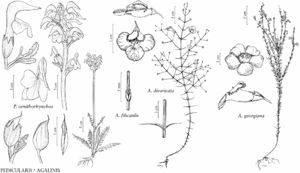Difference between revisions of "Pedicularis ornithorhynchos"
Fl. Bor.-Amer. 2: 108. 1838.
FNA>Volume Importer |
FNA>Volume Importer |
||
| Line 31: | Line 31: | ||
|elevation=200–2400 m. | |elevation=200–2400 m. | ||
|distribution=B.C.;Alaska;Wash. | |distribution=B.C.;Alaska;Wash. | ||
| − | |discussion=<p>Pedicularis ornithorhynchos is commonly misspelled in the literature as P. ornithorhyncha. As this is the orthography used in floras since C. L. Hitchcock et al. (1955–1969, vol. 4), it also appears on recent herbarium specimens. How this error arose is unclear because the same misspelling also appears on specimens older than 1959. Another occasional misspelling is ornithorhynchus.</p><!-- | + | |discussion=<p><i>Pedicularis ornithorhynchos</i> is commonly misspelled in the literature as P. ornithorhyncha. As this is the orthography used in floras since C. L. Hitchcock et al. (1955–1969, vol. 4), it also appears on recent herbarium specimens. How this error arose is unclear because the same misspelling also appears on specimens older than 1959. Another occasional misspelling is ornithorhynchus.</p><!-- |
| − | --><p>The galeas of Pedicularis ornithorhynchos taper into long conical, uncoiled beaks that are very conspicuous above the horizontally expanded lateral lobes of the abaxial lips. No more than 15 flowers are borne on the capitate heads, with the internodes greatly expanding as the fruits develop. Compared to the basal leaves, the cauline leaves of the inflorescence are very few and much shorter, but otherwise similar in form. This alpine and tundra species occurs in the Alaskan panhandle and Coast Mountains as well as the coast ranges of mainland British Columbia south into the northern Cascade Range as far south as Mount Rainier; it is also recorded from alpine areas on Vancouver Island and the Haida Gwaii (Queen Charlotte Islands), British Columbia.</p><!-- | + | --><p>The galeas of <i>Pedicularis ornithorhynchos</i> taper into long conical, uncoiled beaks that are very conspicuous above the horizontally expanded lateral lobes of the abaxial lips. No more than 15 flowers are borne on the capitate heads, with the internodes greatly expanding as the fruits develop. Compared to the basal leaves, the cauline leaves of the inflorescence are very few and much shorter, but otherwise similar in form. This alpine and tundra species occurs in the Alaskan panhandle and Coast Mountains as well as the coast ranges of mainland British Columbia south into the northern Cascade Range as far south as Mount Rainier; it is also recorded from alpine areas on Vancouver Island and the Haida Gwaii (Queen Charlotte Islands), British Columbia.</p><!-- |
| − | --><p>Pedicularis ornithorhynchos is pollinated by bumblebees that hang inverted from the galea and cause release of pollen by wing-muscle vibrations (L. W. Macior 1973).</p> | + | --><p><i>Pedicularis ornithorhynchos</i> is pollinated by bumblebees that hang inverted from the galea and cause release of pollen by wing-muscle vibrations (L. W. Macior 1973).</p> |
|tables= | |tables= | ||
|references= | |references= | ||
| Line 57: | Line 57: | ||
|publication year=1838 | |publication year=1838 | ||
|special status=Selected by author to be illustrated;Endemic | |special status=Selected by author to be illustrated;Endemic | ||
| − | |source xml=https://jpend@bitbucket.org/aafc-mbb/fna-data-curation.git/src/ | + | |source xml=https://jpend@bitbucket.org/aafc-mbb/fna-data-curation.git/src/8f726806613d60c220dc4493de13607dd3150896/coarse_grained_fna_xml/V17/V17_924.xml |
|genus=Pedicularis | |genus=Pedicularis | ||
|species=Pedicularis ornithorhynchos | |species=Pedicularis ornithorhynchos | ||
Revision as of 15:04, 18 September 2019
Plants 10–25 cm. Leaves: basal 2–10, blade lanceolate to oblanceolate, 15–80 x 3–10 mm, 1- or 2-pinnatifid, margins of adjacent lobes nonoverlapping or slightly overlapping distally, entire or serrate, surfaces glabrous; cauline 0–4, blade lanceolate, 5–40 x 3–15 mm, 1- or 2-pinnatifid, margins of adjacent lobes nonoverlapping or slightly overlapping distally, serrate, surfaces glabrous. Racemes simple, 1–5, exceeding basal leaves, each 4–15-flowered; bracts trullate, sometimes lanceolate, 5–13 x 1–3 mm, +/- lobed, margins entire or serrate, surfaces glabrous or tomentose. Pedicels 3–6 mm. Flowers: calyx 6.5–9 mm, tomentose, lobes 5, triangular, 2.5–4 mm, apex entire or serrulate, glabrous or ciliate; corolla 12–15 mm, tube lavender, 8–9 mm; galea lavender, 4–6.5 mm, beaked, beak straight, 2–6.5 mm, margins entire medially and distally, apex extending beyond abaxial lip; abaxial lip pink, 6–8 mm. 2n = 16.
Phenology: Flowering Jul–Sep.
Habitat: Moist alpine meadows, heathlands, tundras.
Elevation: 200–2400 m.
Distribution
B.C., Alaska, Wash.
Discussion
Pedicularis ornithorhynchos is commonly misspelled in the literature as P. ornithorhyncha. As this is the orthography used in floras since C. L. Hitchcock et al. (1955–1969, vol. 4), it also appears on recent herbarium specimens. How this error arose is unclear because the same misspelling also appears on specimens older than 1959. Another occasional misspelling is ornithorhynchus.
The galeas of Pedicularis ornithorhynchos taper into long conical, uncoiled beaks that are very conspicuous above the horizontally expanded lateral lobes of the abaxial lips. No more than 15 flowers are borne on the capitate heads, with the internodes greatly expanding as the fruits develop. Compared to the basal leaves, the cauline leaves of the inflorescence are very few and much shorter, but otherwise similar in form. This alpine and tundra species occurs in the Alaskan panhandle and Coast Mountains as well as the coast ranges of mainland British Columbia south into the northern Cascade Range as far south as Mount Rainier; it is also recorded from alpine areas on Vancouver Island and the Haida Gwaii (Queen Charlotte Islands), British Columbia.
Pedicularis ornithorhynchos is pollinated by bumblebees that hang inverted from the galea and cause release of pollen by wing-muscle vibrations (L. W. Macior 1973).
Selected References
None.
